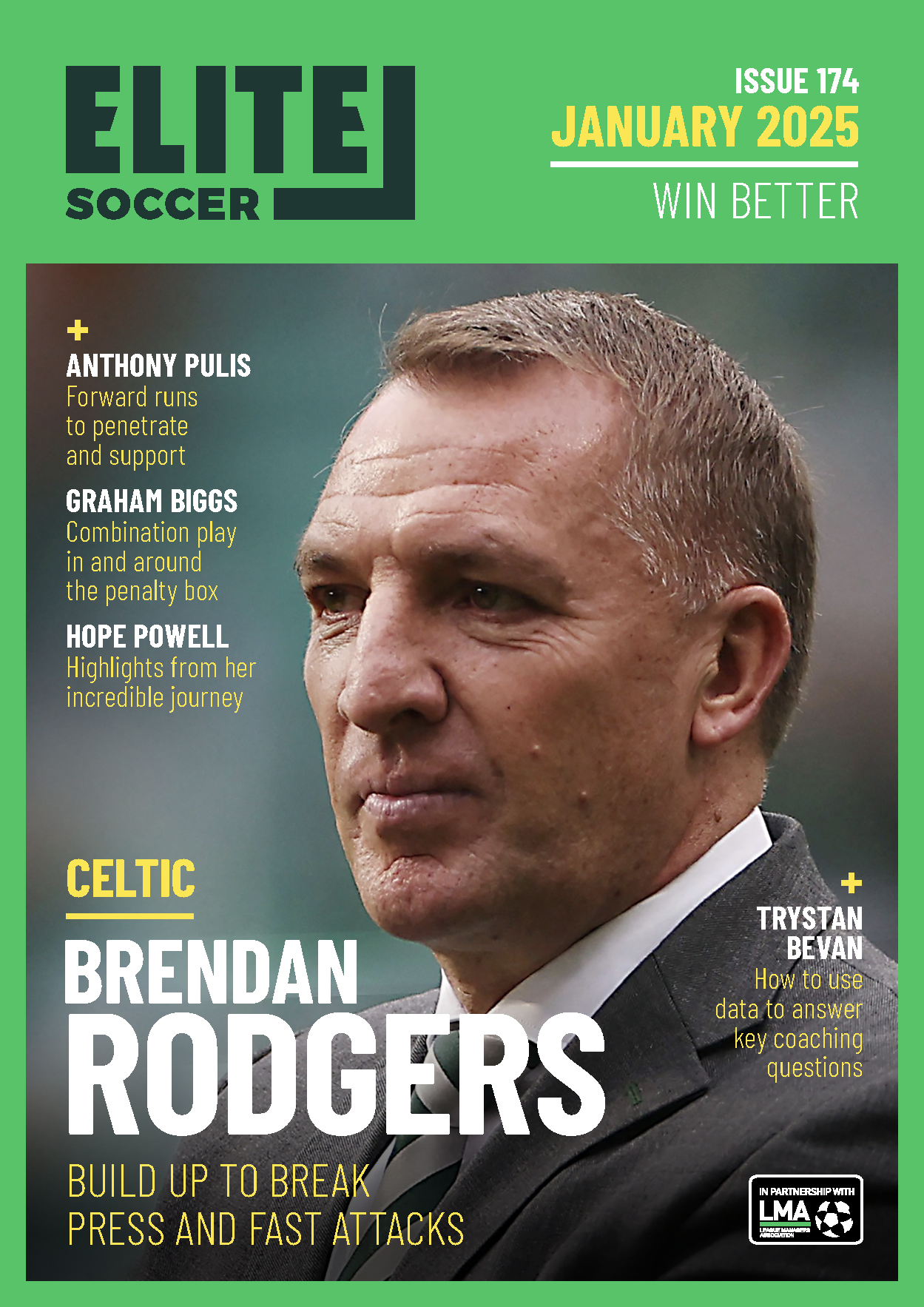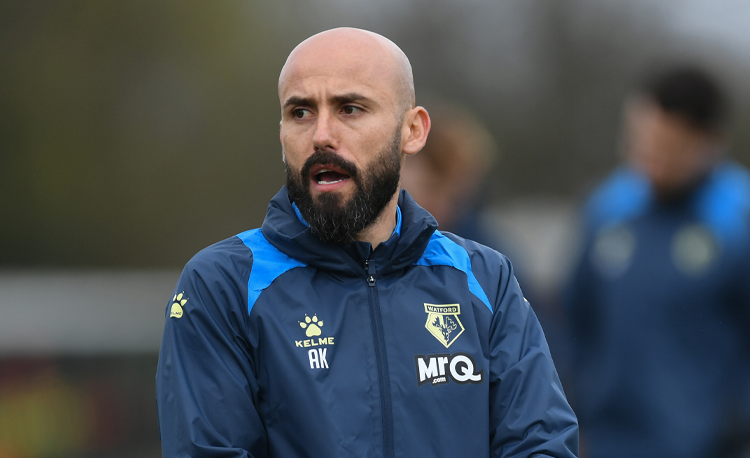You are viewing 1 of your 1 free articles
Counter-attacking
Use this dynamic counter-attacking session to encourage your players to attack with speed and a sense of urgency. It is also a good test for defensive players, giving them plenty of experience in combatting a counter attack.
| Area | Up to full pitch |
| Equipment | Balls, bibs, cones, 2 mannequins, 4 mini goals, 2 full size goals |
| No. of Players | Up to 20 players + 2 goalkeepers |
| Session Time | Counter attack 3v2: 12mins, Counter attack 5v4: 15mins, 11v11 game: 18mins |
This session is focused on counter-attacking, with the emphasis on encouraging teams to attack with speed and a sense of urgency. It’s a session that creates numerous counter-attacking situations and players get to experience 3v2, 5v4 and 1v1 scenarios. It is also a good test for defensive players, giving them plenty of experience in combatting a counter-attack, especially when outnumbered.
The session ultimately progresses towards the final activity, which puts everything that the players have learnt into an 11v11 game.
What do I get the players to do?
Counter-attack 3v2 plus 1v1
We set up on two thirds of a pitch, with a goal and a goalkeeper at one end. Two target goals and a mannequin are positioned on each side in a wide zone. We’re using 17 outfield players, divided into 11 attackers and six defenders, starting as shown [1a].
1a
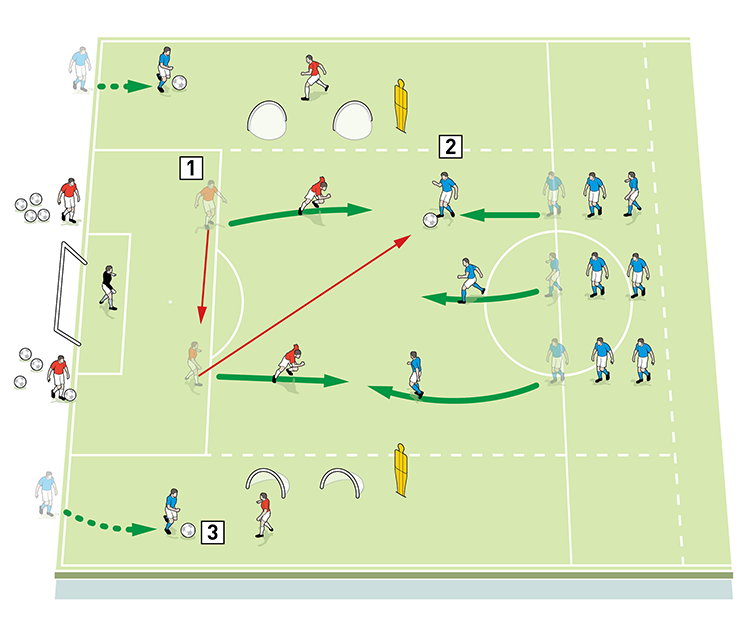
2. The first wave of attackers have seven seconds to counter attack the goal in a 3v2
3. At the same time, an attacker dribbles into each wide zone in a 1v1. He must score in a mini goal or run beyond the mannequin
Two defenders begin by combining to bring the ball out of the penalty area before hitting a diagonal pass up the pitch to the first wave of attackers, who counter-attack against the defenders in a 3v2. They have seven seconds to complete the attack with a shot on goal.
At the same time as the central attack is going on, the attackers in each corner dribble into the wide zone and take on a defender in a 1v1. They should either play the ball inside to score in the target goals or run beyond the mannequin.
Once the attack has finished, players move as shown [1b]. The central striker re-joins the back of the central queue where he started, ready to take part in the next 3v2. The other two attackers from the 3v2 switch roles with the wide attackers, so they all get to practise both the 1v1 and 3v2 attacks. The defenders rotate their starting positions for the same reason. Play four blocks of three minutes.
1b

2. The central striker stays in the 3v2, joining the back of the queue
3. The attackers in the wide zones swap places with the two outside attackers in the 3v2
4. The red defenders swap roles too, rotating into new starting positions
How do I progress the practice?
As the activity progresses and the players get used to it, change the time limit on the attack to make it quicker by giving the players, say, five seconds to attack instead of seven seconds.
What are the key things to look out for?
The speed of the counter-attack is vital, which is why we impose a time limit on the attack. If necessary, the coach can count down the seven-second time limit to instil a sense of urgency in the attacking players.
The two players on each side of the centre forward in the 3v2 must not drift too wide to be able to score, which is why we cone off the central attacking area to the width of the penalty area.
What do I get the players to do next?
Counter-attack 5v4
We set up on two thirds of a pitch, coned off from the corners of the penalty area to the ends of the halfway line. This is designed to force any counter-attack in the direction of the goal.
We’re using a goal and a goalkeeper at one end. We’re using 16 outfield players, split into two waves of five attackers and six defending players. The defending players are made up of two central defenders, two active defensive midfielders and two more who are waiting for their turn. Each wave of attackers is made up of a centre forward, two wide attackers and two attacking midfielders.
To start the practice, the two centre backs combine to play a pass in the direction of a team mate over the halfway line, which is intercepted by an attacking midfielder. The first wave of attackers must then counter-attack, with the player that intercepted the ball having to pass with his second touch, as shown [2a]. After the pass is played, the defending midfielders can then track back to defend, making it 5v4 in favour of the attackers, as shown [2b]. The defending players must communicate as they recover and should try to stop the counter-attack.
2a
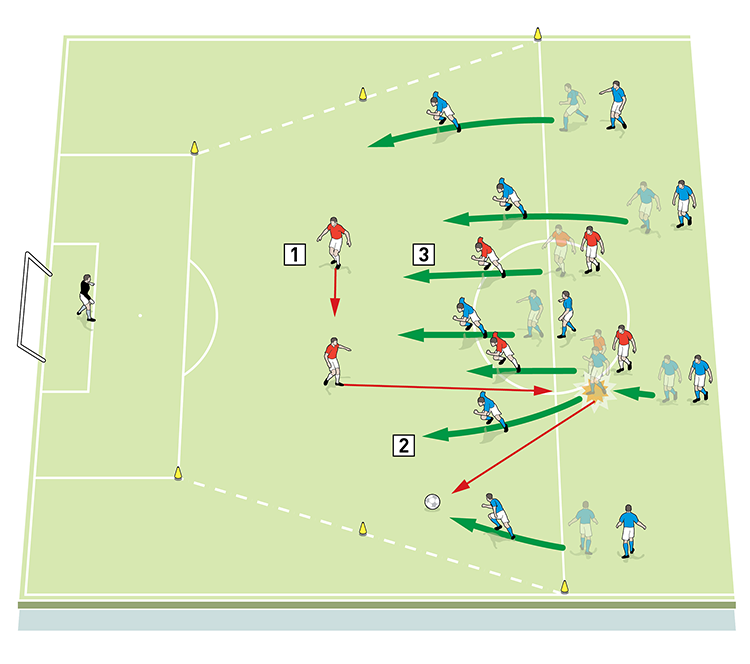
2. A blue intercepts and launches a counter-attack by the first wave of blues. They have seven seconds to score
3. The red midfielders track back to defend, making it 5v4 in favour of the blues
2b
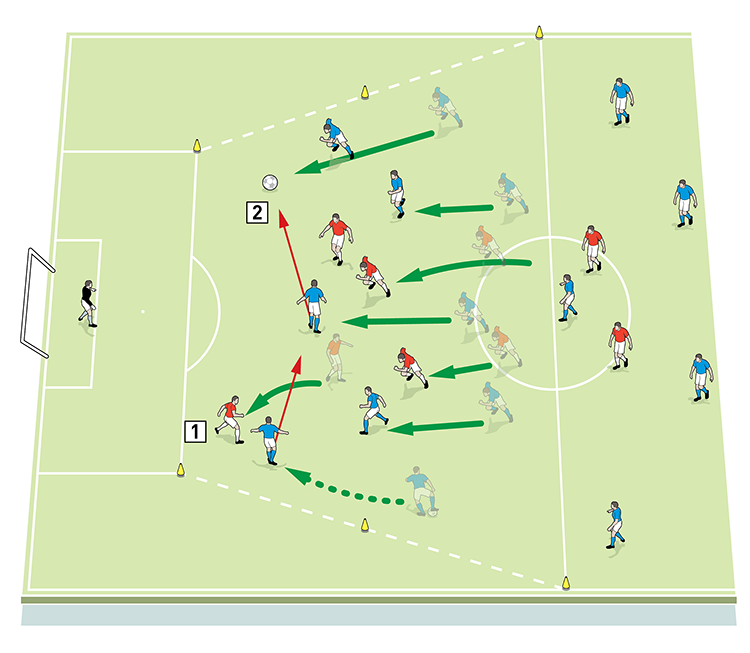
2. The blues use the overload well and quick passing stretches the recovering defenders
The attackers have an overload, which should help them take advantage of the situation, but they are allowed only seven seconds to try to score.
How would I put this into a game situation?
11v11 game
We set up on a full size pitch to play an 11v11 game. Set it up so the counter-attacking team remains low and compact, so they can win the ball and make the counter-attack successful, as shown [3]. If the counter-attacking team fail to win possession and are unable to start a counter-attack within two minutes, the coach must manufacture a counter-attacking opportunity by playing a second ball into them and play continues from there.
3
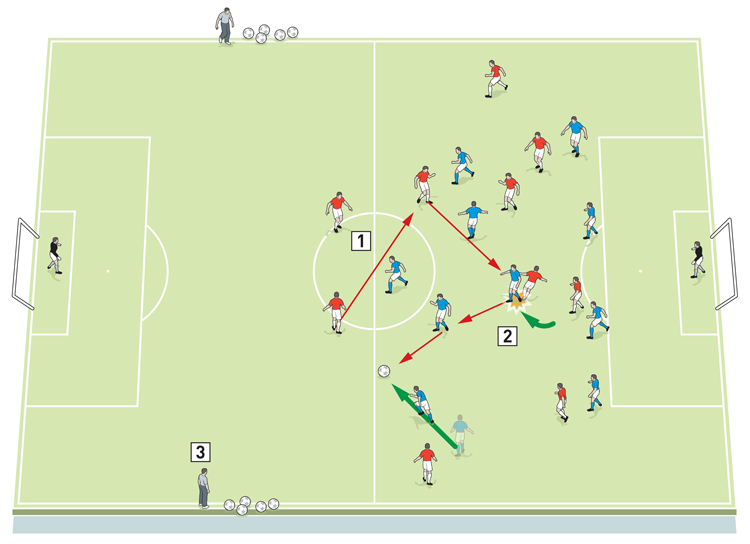
2. Set up the counter-attacking team so they remain low and compact. This will help them to win the ball and launch a counter-attack
3. If the counter-attackers don’t win the ball within two minutes, the coach creates a counter-attack by playing a second ball to them from wide
Once the attack has either been successful or has broken down, set up again and start play from the centre circle with the opposition team in possession again and the counter-attacking team defending.
Related Files
Editor's Picks
Using the goalkeeper in build-up play
Pressing principles
Intensive boxes drill with goals
Penetrating the final third
Creating and finishing
My philosophy
Pressing initiation
Compact team movement
Defensive organisation
Coaches' Testimonials

Alan Pardew

Arsène Wenger

Brendan Rodgers

Carlos Carvalhal

José Mourinho

Jürgen Klopp

Pep Guardiola

Roy Hodgson

Sir Alex Ferguson

Steven Gerrard
Coaches' Testimonials

Gerald Kearney, Downtown Las Vegas Soccer Club

Paul Butler, Florida, USA

Rick Shields, Springboro, USA

Tony Green, Pierrefonds Titans, Quebec, Canada
Join the world's leading coaches and managers and discover for yourself one of the best kept secrets in coaching. No other training tool on the planet is written or read by the calibre of names you’ll find in Elite Soccer.
In a recent survey 92% of subscribers said Elite Soccer makes them more confident, 89% said it makes them a more effective coach and 91% said it makes them more inspired.
Get Monthly Inspiration
All the latest techniques and approaches
Since 2010 Elite Soccer has given subscribers exclusive insight into the training ground practices of the world’s best coaches. Published in partnership with the League Managers Association we have unparalleled access to the leading lights in the English leagues, as well as a host of international managers.
Elite Soccer exclusively features sessions written by the coaches themselves. There are no observed sessions and no sessions “in the style of”, just first-hand advice delivered direct to you from the coach.



